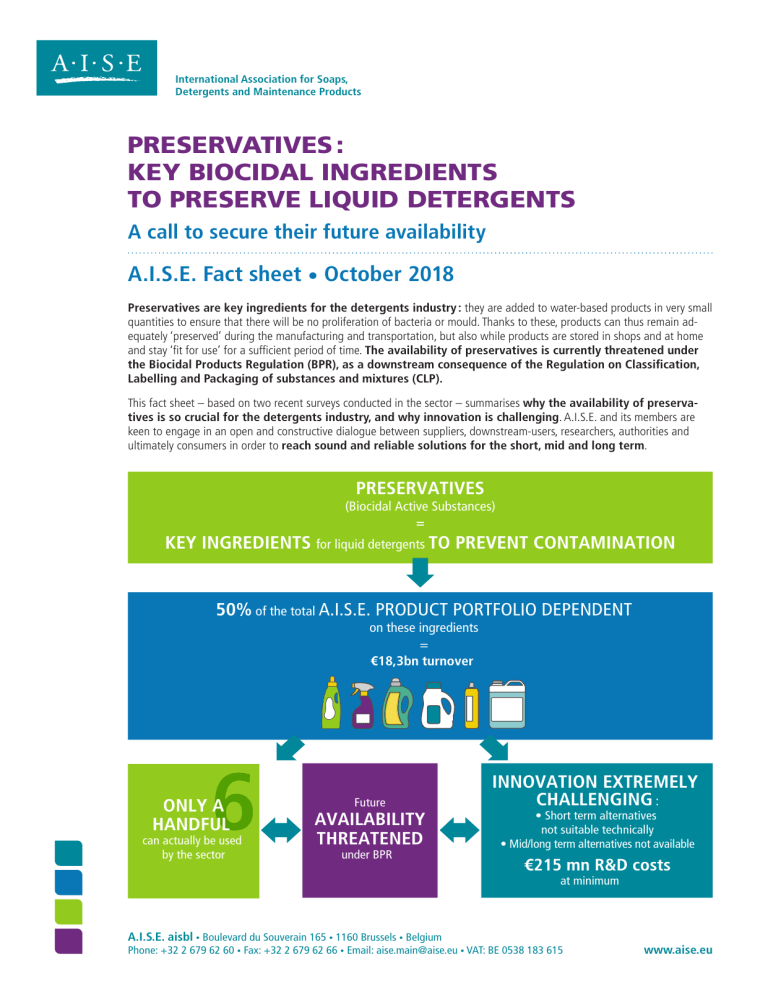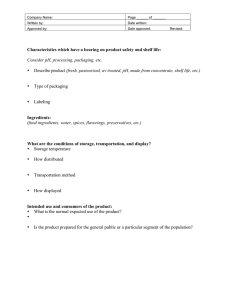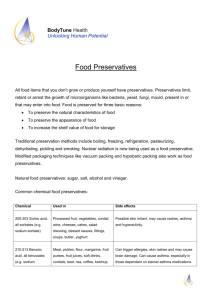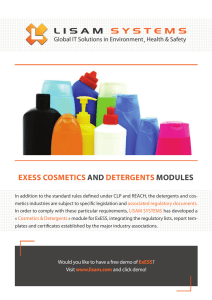
International Association for Soaps, Detergents and Maintenance Products Preservatives : Key biocidal ingredients to Preserve liquid detergents A call to secure their future availability A.I.S.E. Fact sheet • October 2018 Preservatives are key ingredients for the detergents industry : they are added to water-based products in very small quantities to ensure that there will be no proliferation of bacteria or mould. Thanks to these, products can thus remain adequately ‘preserved’ during the manufacturing and transportation, but also while products are stored in shops and at home and stay ‘fit for use’ for a sufficient period of time. The availability of preservatives is currently threatened under the Biocidal Products Regulation (BPR), as a downstream consequence of the Regulation on Classification, Labelling and Packaging of substances and mixtures (CLP). This fact sheet – based on two recent surveys conducted in the sector – summarises why the availability of preservatives is so crucial for the detergents industry, and why innovation is challenging. A.I.S.E. and its members are keen to engage in an open and constructive dialogue between suppliers, downstream-users, researchers, authorities and ultimately consumers in order to reach sound and reliable solutions for the short, mid and long term. PRESERVATIVES (Biocidal Active Substances) = KEY INGREDIENTS for liquid detergents TO PREVENT CONTAMINATION 50% of the total A.I.S.E. PRODUCT PORTFOLIO DEPENDENT on these ingredients = €18,3bn turnover 6 ONLY A HANDFUL can actually be used by the sector Future AVAILABILITY THREATENED under BPR INNOVATION EXTREMELY CHALLENGING : • Short term alternatives not suitable technically • Mid/long term alternatives not available €215 mn R&D costs at minimum A.I.S.E. aisbl • Boulevard du Souverain 165 • 1160 Brussels • Belgium Phone: +32 2 679 62 60 • Fax: +32 2 679 62 66 • Email: aise.main@aise.eu • VAT: BE 0538 183 615 www.aise.eu PRESERvATIvES kEy IngREDIEnTS FOR LIQUID DETERGENTS • Preservatives are biocides (“Product Type 6” – PT6) under Biocidal Products Regulation (BPR) which play a without preservatives fundamental role to prevent product contamination and thus : ^ avoid that products are damaged between manufacturing and final use, ensuring no product loss ^ secure that products have durable shelf and storage life ^ keep products fit for use by consumers After some time, liquid ^ and eventually, support sustainability by detergents with no preservatives start to degrade. optimising use of resources. >50% OF A.I.S.E.’S TURNOVER DEPEnDEnT • The current market trend – in line with consumer choices – shows an increasing preference for liquid formats ; these also enable compaction and sustainability savings as liquid formats can be produced in a less energy intensive way. Powders Mn € TOTAL ACTIvE SUBSTAnCES with preservatives 25 TECHnICAL LIMITATIOnS 16 TOxICOLOgICAL RESTRICTIOnS Liquids 6000 4000 2000 0 50 2008 2009 2010 2011 2012 2013 2014 2015 2016 2017 • Product portfolio concerned : Water-based liquid detergents in the household care business and for professional cleaning and hygiene usages. =>50% of the total A.I.S.E product portfolio affected 6 CAN BE USED In 10 years, the household liquid laundry detergent market (used here as example) has taken over sales vs powders. (source Euromonitor - EU 28 - Retail Sales Prices) Preservatives need to be stable in the formulation and need to guarantee a reasonable shelf life (estimated on average at 2 years). 24% 36% Surfactant incompatibility Many preservatives are not technically compatible with surfactants which are the core functional ingredients for detergency; this thus renders their use impossible for detergents. Limited pH range Limited spectrum/efficacy Preservatives need to be able to control the various micro-organisms – i.e. multiple types of bacteria, fungi and yeasts – that can develop in water-based formulations. 20% 20% These are Active Substances whose toxicological profile (carcinogenic, toxic for reproduction, respiratory sensitiser...) prevents industry from using them. Those are preservatives which can only be used in acidic formulations, hence, for a limited product range (fabric softeners, acidic cleaners). They cannot be used to preserve other categories (bigger in volume) such as laundry/dish detergents, all purpose cleaners (neutral or alkaline pH). A.I.S.E Survey 2016 on the use of in-can preser vatives : • 88 respondents (househol d and professional sector) • Representing around 60 % of the EU turnover based on Euromonitor data 3 These new ones are additional Active Substances which have recently been added by EU Authorities for PT6 uses but for which there is no experience yet nor confirmation that they can meet the detergents industry’s needs. 6 THE FEw PRESERVATIVES RELEVANT FOR THE DETERGENTS INDUSTRY NOW THREATEnED nEw SUBSTAnCES 2007 The vast majority of the current list of Active Substances available under PT6 can actually not be used by the detergent industry for various reasons as explained below. Instability/short shelf life 44 CANNOT BE USED • Water-based liquid detergents need a method of preservation ; without this, they would be contaminated by the proliferation of micro-organisms. ALMOST 90% OF PRESERVATIVES CAnnOT BE USED BY THE DETERGENTS INDUSTRY USED BIT Bronopol • Out of the 50 different Active Subtances (AS) available, only a handful of these are actually technically compatible with detergent and maintenance product formulations. And about MIT* • Industry is concerned about the consequences of CLP decisions that may lead to a ban of these substances under BPR. • * As a consequence, there is a further risk that this list could even be shortened in the near future = Recent classification update adopted by EU Authorities as skin sensitiser with too low classification threshold challenges the future use by industry of these specific substances. 60% CMIT/MIT* • Detergent manufacturers already suffer from a very fragile supply chain due to the limited number of suppliers. • The downstream consequences of hazardous classification drive industry into reformulation whilst some ingredients can be safely used in detergents and cleaning products (see graph below). About of the total household market (laundry detergents, laundry aids, fabric conditioners, surfaces cleaners, hand dishwashing, insecticides, air fresheners etc). Phenoxyethanol OIT The substances most used by the detergents industry are shown in the largest font. Different ‘treatments’ for the same substance under CLP and BPR : LINK WITH NO LEGAL BASIS(1) 13% of the professional cleaning sector th : Eftec study (2017) ran wi totalling d and professional sector), • 59 companies (househol rket share together about 71% EU ma (1) (3) CLP(2) OK to use > x% BPR(3) > x% NOT OK to use But label accordingly Substance A But already a precedent with CMIT/MIT – (2) CLP Regulation (EC) No 1272/2008 on classification, labelling and packaging of substances and mixtures BPR Regulation (EU) No 528/2012 concerning the making available on the market and use of biocidal products INDUSTRY CHALLENGES PRESERvATIvES R&D MARkET ACCEPTAnCE? INNOVATION CHALLENGES CLASSIFICATIOn? € The detergent industry has been seeking to find innovative solutions but with no tangible viable solutions yet for various reasons. • The development of new substances is a very challenging and costly process which is not in the hands of downstream users. In addition, other means to preserve products are not conceivable nor sustainable (for example storing liquid detergents in fridges throughout the supply chain and even at home). • Delivering products and/or services without preservatives may be subject to long-term innovations but : ^ would require time as well as major R&D investments – challenging for SMEs ; ^ will need market acceptance and drastic habit changes… for quasi the entirety of the product portfolio ; ^ will very likely lead to issues due to more severe classification of products. A.I.S.E. and its members are keen to engage in an open and constructive dialogue between all stakeholders in order to reach sound and reliable solutions for the short, mid and long term. Short term alternatives Mid term alternatives Long term innovations • Existing substances • Technical limitations • Not as effective • Lead by suppliers • New substances? • Availability? • As effective? • Classification? • Reduced water composition • Move to super concentrated formats (eg to be diluted in water) • Safe use? • Market acceptance? • Classification? (contamination risks) • Inability to reformulate? Estimated R&D costs Estimated R&D costs of reformulating AwAy FROM the 5 most used preservatives with other existing ones : of reformulating wITHOUT Any preservatives at all : + 3% min. increase cost/formula + € 1,8 million/company (production) Average time to reformulate = 2 to 4 years (SMEs - Multinationals) €215 million Higher costs/formula Average time to reformulate : 5 - 10 years minimum Higher than €215 million ^ Away from R&D + Profits ^ Leading to higher prices for consumers th : Eftec study (2017) ran wi totalling d and professional sector), • 59 companies (househol rket share together about 71% EU ma IT/MIT, d preservatives (BIT, MIT, CM • Focusing on 5 most use bronopol, phenoxyethanol) A.I.S.E. aisbl • Boulevard du Souverain 165 • 1160 Brussels • Belgium Phone: +32 2 679 62 60 • Fax: +32 2 679 62 66 • Email: aise.main@aise.eu • VAT: BE 0538 183 615 www.aise.eu ©A.I.S.E. October 2018


